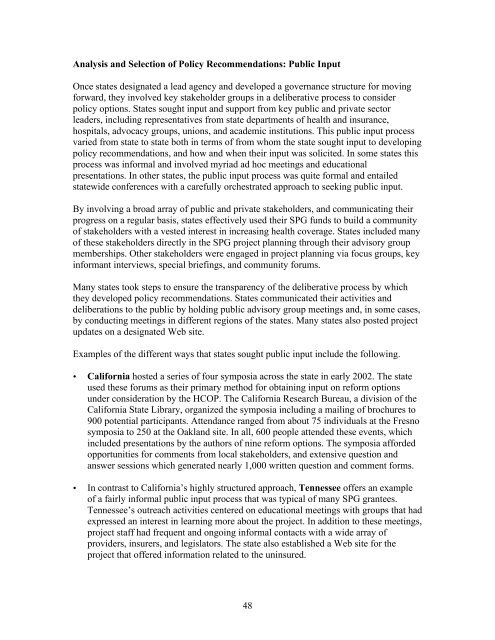SPG synthesis report - State Coverage Initiatives
SPG synthesis report - State Coverage Initiatives
SPG synthesis report - State Coverage Initiatives
You also want an ePaper? Increase the reach of your titles
YUMPU automatically turns print PDFs into web optimized ePapers that Google loves.
Analysis and Selection of Policy Recommendations: Public Input<br />
Once states designated a lead agency and developed a governance structure for moving<br />
forward, they involved key stakeholder groups in a deliberative process to consider<br />
policy options. <strong>State</strong>s sought input and support from key public and private sector<br />
leaders, including representatives from state departments of health and insurance,<br />
hospitals, advocacy groups, unions, and academic institutions. This public input process<br />
varied from state to state both in terms of from whom the state sought input to developing<br />
policy recommendations, and how and when their input was solicited. In some states this<br />
process was informal and involved myriad ad hoc meetings and educational<br />
presentations. In other states, the public input process was quite formal and entailed<br />
statewide conferences with a carefully orchestrated approach to seeking public input.<br />
By involving a broad array of public and private stakeholders, and communicating their<br />
progress on a regular basis, states effectively used their <strong>SPG</strong> funds to build a community<br />
of stakeholders with a vested interest in increasing health coverage. <strong>State</strong>s included many<br />
of these stakeholders directly in the <strong>SPG</strong> project planning through their advisory group<br />
memberships. Other stakeholders were engaged in project planning via focus groups, key<br />
informant interviews, special briefings, and community forums.<br />
Many states took steps to ensure the transparency of the deliberative process by which<br />
they developed policy recommendations. <strong>State</strong>s communicated their activities and<br />
deliberations to the public by holding public advisory group meetings and, in some cases,<br />
by conducting meetings in different regions of the states. Many states also posted project<br />
updates on a designated Web site.<br />
Examples of the different ways that states sought public input include the following.<br />
• California hosted a series of four symposia across the state in early 2002. The state<br />
used these forums as their primary method for obtaining input on reform options<br />
under consideration by the HCOP. The California Research Bureau, a division of the<br />
California <strong>State</strong> Library, organized the symposia including a mailing of brochures to<br />
900 potential participants. Attendance ranged from about 75 individuals at the Fresno<br />
symposia to 250 at the Oakland site. In all, 600 people attended these events, which<br />
included presentations by the authors of nine reform options. The symposia afforded<br />
opportunities for comments from local stakeholders, and extensive question and<br />
answer sessions which generated nearly 1,000 written question and comment forms.<br />
• In contrast to California’s highly structured approach, Tennessee offers an example<br />
of a fairly informal public input process that was typical of many <strong>SPG</strong> grantees.<br />
Tennessee’s outreach activities centered on educational meetings with groups that had<br />
expressed an interest in learning more about the project. In addition to these meetings,<br />
project staff had frequent and ongoing informal contacts with a wide array of<br />
providers, insurers, and legislators. The state also established a Web site for the<br />
project that offered information related to the uninsured.<br />
48






